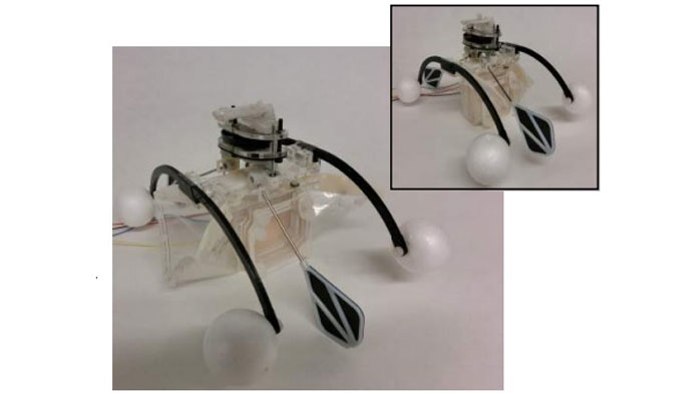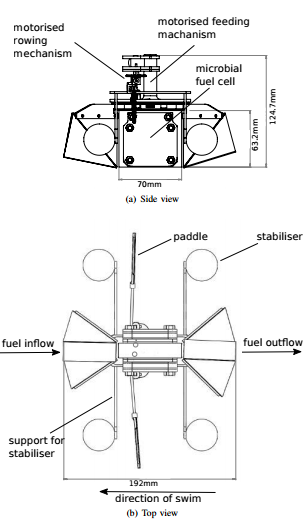Beetle robot “eats” microbes to purify water and get energy for work
A team of scientists from the University of Bristol made Row-bot - a prototype of a robot that is designed to move around the surface of contaminated water bodies and eating microbes. The robot uses germs to receive energy from them and continue to work.

The Bristol Bioenergy Center operates in the field of bioenergy, looking for ways to recycle waste and reap the benefits of electricity from this process. Scientists work at the junction of sanitation and robotics. “We are developing systems that extract electricity from waste, and these systems can be self-sufficient - in the system-engineering sense,” says bioengineer Ioannis Hieropoulos.
A team of scientists used the microbial fuel cell feature to create a Row-bot. MTE is a biotechnological device that converts the energy of chemical bonds of organic substances into electricity through microorganisms. These elements are able to use wastewater, which makes them effective means not only for the production of electrical energy, but also to protect the environment.
Row-bot consists of two main parts: the movement mechanism - a 0.75-watt brush motor and the “oars” driven by it, and the “stomach”, which is a microbial fuel cell. The robot lets water into the tank and uses the microbes received with it to produce electric current.
MTE consists of two chambers - the anode, where water with bacteria is placed, and the cathode. “Bacteria inside the anode chamber receive a carbon source of energy that they need to grow and sustain. But because they are in a chamber with an electrode, the only way to survive for them is to process the organic substrate that we feed them, and they carry out anaerobic respiration through this electrode. A unique feature of this technology is that bacteria do exactly the same thing as in vivo, but in MTE, as a result of anaerobic respiration, electrons leave the inside of the bacterial cell and fall on the electrode. This electrode in the anode chamber, the negative electrode, is connected by a circuit or wire to the cathode. And this is the path that electrons travel. Electrons moving from the negative electrode to the positive form an electric current produced by this device. This is the principle of MTE, ”explains Ioannis Hieropoulos.
Scientists are confident that this device has the potential to be used as a non-volatile robot for cleaning water bodies and for monitoring the environment. The next step of the team will be to add monitoring systems to the beetle robot that will work on MTE.


The Bristol Bioenergy Center operates in the field of bioenergy, looking for ways to recycle waste and reap the benefits of electricity from this process. Scientists work at the junction of sanitation and robotics. “We are developing systems that extract electricity from waste, and these systems can be self-sufficient - in the system-engineering sense,” says bioengineer Ioannis Hieropoulos.
A team of scientists used the microbial fuel cell feature to create a Row-bot. MTE is a biotechnological device that converts the energy of chemical bonds of organic substances into electricity through microorganisms. These elements are able to use wastewater, which makes them effective means not only for the production of electrical energy, but also to protect the environment.
Row-bot consists of two main parts: the movement mechanism - a 0.75-watt brush motor and the “oars” driven by it, and the “stomach”, which is a microbial fuel cell. The robot lets water into the tank and uses the microbes received with it to produce electric current.
MTE consists of two chambers - the anode, where water with bacteria is placed, and the cathode. “Bacteria inside the anode chamber receive a carbon source of energy that they need to grow and sustain. But because they are in a chamber with an electrode, the only way to survive for them is to process the organic substrate that we feed them, and they carry out anaerobic respiration through this electrode. A unique feature of this technology is that bacteria do exactly the same thing as in vivo, but in MTE, as a result of anaerobic respiration, electrons leave the inside of the bacterial cell and fall on the electrode. This electrode in the anode chamber, the negative electrode, is connected by a circuit or wire to the cathode. And this is the path that electrons travel. Electrons moving from the negative electrode to the positive form an electric current produced by this device. This is the principle of MTE, ”explains Ioannis Hieropoulos.
Scientists are confident that this device has the potential to be used as a non-volatile robot for cleaning water bodies and for monitoring the environment. The next step of the team will be to add monitoring systems to the beetle robot that will work on MTE.

